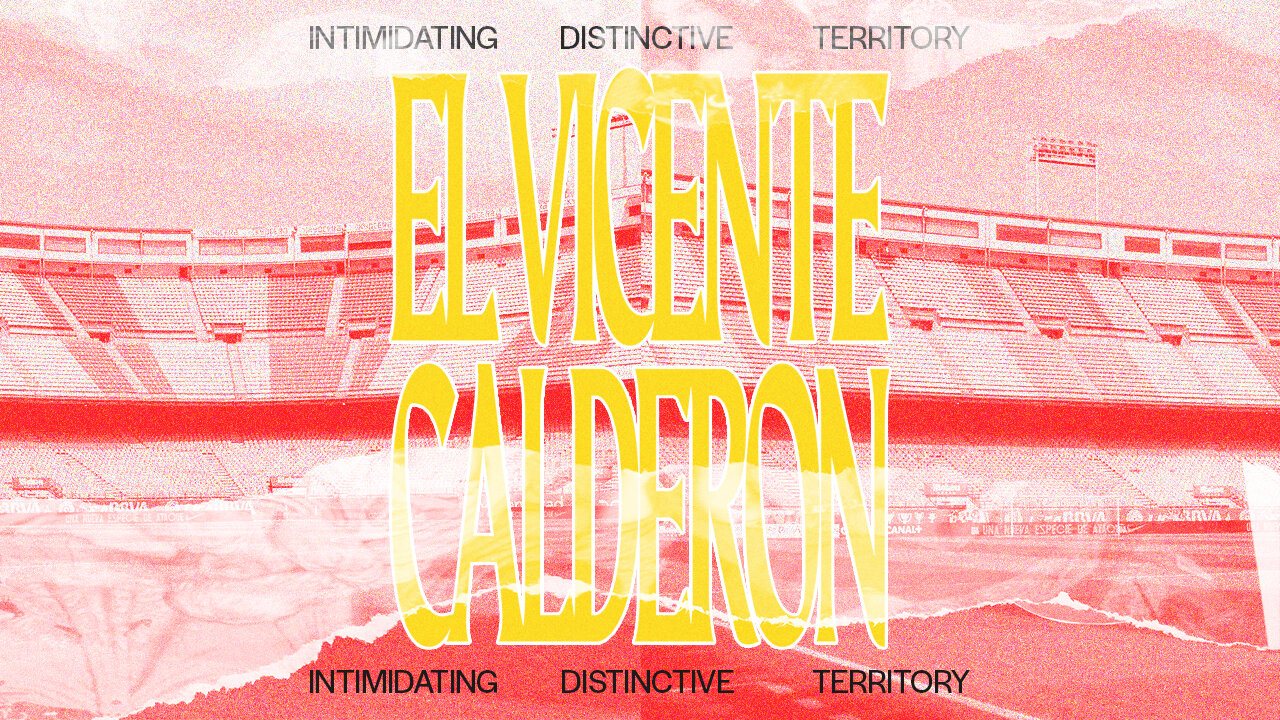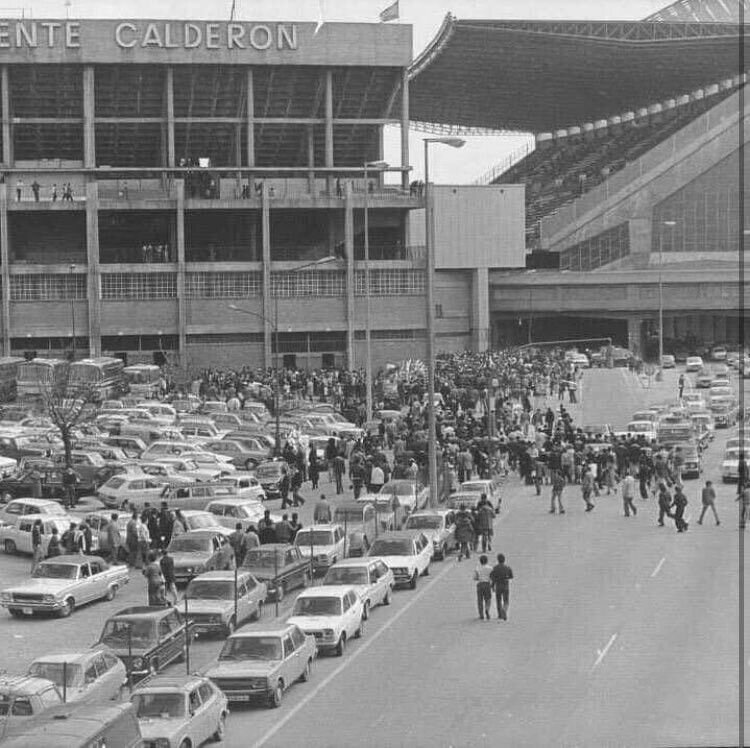Remembering The Vicente Calderón
Another rendition of Los Himnos Del Atleti fizzles out. Red cans of Mahou are launched through the air. The Pirámides metro station is a reverberating noise funnel: scarves twirling, flags draped, waves and waves of consolatory red and white. I crunch and stamp on the empty cans and traipse up the exit stairs into the streets of the Arganzuela district. The roads are packed and the bars are stuffed. As the sea of red and white marches towards the Vicente Calderón, small huddles of Eibar fans in green are treated with as much respect as one might expect. After all, this is the home of Club Atlético de Madrid: a seething, whistling pit of bias.
It is almost the perfect Winter afternoon. The sky in the Spanish capital is powder blue, and as I make the trek up the North Stand to reach my seat right up in the gods, I am a kid again. I feel like I have just seen a football stadium for the first time in my life: in awe of the deep green of the stage; the way the intense light emerges as you take the concourse steps; the way the crackle of electricity around this concrete amphitheatre echoes from top to bottom. Opposite me, the Atleti ultras in the Curva Sud stand and spread their scarves from right to left: thousands of them, all immaculately dressed in Atleti red and white, all noisy and sinister. As the teams emerge, I realise that this was one of those sporting occasions that I was going to be watching through the prism of the fans, the whole match played out through their reactions.
It is another vital match for Atleti after no win in their last three games. Barça and Real have taken charge at the top of La Liga. Pursuing their second league title in three years, Diego Simeone’s men needed to beat Eibar at the Calderón. The away side took the lead a minute after the half-time interval; Keko taking advantage of a defensive error. But taking the lead was possibly the worst case scenario for the Basque visitors. If there is one thing the Atlético fans epitomise it is intense and visceral passion. The team thrives off it. After silencing their hosts for all of ten second half minutes, Eibar eventually squeal like piglets. And seven minutes after José Giménez’s close range header, Saul followed suit, turning the game on its head. The minutes wore on and Diego Simeone’s men had victory firmly in their grasp. They could have seen the game out as it was. But Los Rojiblancos wanted to entertain.
Fernando Torres, a 76th minute substitute, has a moment of Atlético Madrid history within touching distance. In stoppage time, Luciano Vietto makes a run in behind the full-back, takes a touch to get the ball out of his feet, and fires in a low, left-footed cross. Losing his man, Torres meets the cross to stab into an open net, scoring his 100th Atlético Madrid goal.
At which point the whole evening fell apart. Fans in the stadium’s South Stand jumped and leapt and spun and stood on seats. We all know that different types of goals elicit different types of sounds. A last-minute winner usually encourages a high-pitched roar, borne out of disbelief and happiness. But when a club legend - who left for the Premier League and returns for a homecoming - scores a century for the club he devoted his childhood to, the noise is unimaginable. The goosebumps are instant, devastating, like no other feeling in the world. This was, for the most part, European football in its purest distillation. It is why so many football lovers queue up at Heathrow airport to catch a flight to Madrid or sit in a virtual queue on the Barcelona website to get tickets to see Lionel Messi in the flesh: for those fleeting moments of brilliance, to experience the way nerves are bottled up, and then fizz when the ball hits the net.
The fans spilt into the concourses and onto the banks of the Manzanares singing I Can’t Take My Eyes Off You: a dedication to Fernando Torres. Residents stood on their balconies and joined in the chaos, filling the night with song. One merchandise stall, just off the M-30 motorway which bends under the North Stand, was selling ‘Torres 100’ replica shirts, with postcards of El Niño - The Kid - selling rapidly. He must have been waiting a while. Torres himself had been waiting to hit the landmark for his boyhood club for 20 matches, with Atlético facing every La Liga team since his last goal, which coincidentally also came against Eibar. Nearly 15 years had passed since his first Atlético goal against Albacete in June 2001, when he was just 17 years old.
On my way out I get lost in the maze of the apartment blocks as I head back to the Metro station. My Spanish friend, with whom I was staying, was meeting me after the game. He looks happy but also jealous. “I can’t believe it. The one match you go to, you see a moment of history,” he laughed. He didn’t really like football. In a city like Madrid, that is rare. But he still felt something. We head back towards Puerta del Sol in central Madrid, where fans congregate and chant. La Casa Blanca weren’t playing until tomorrow, and are in Andalusia as they travel to face Granada, so the night belonged to Atleti, and to Fernando Torres.
The next morning everything is still raw and undigested. It keeps flickering away on endless replay in the back of my head. I had witnessed history.
“But as I sipped my morning coffee in a dimly lit chocolatería in the heart of Madrid, something hit me. Was my first ever game at the Calderón also going to be my last? “
In 2013, the club announced plans to build a brand new, state-of-the-art stadium in the North-East of the city, 16km away from their home of over fifty years. And despite the crumbling concrete and peeling paint, the decision did not go down well with a large selection of the fanbase, with protests and legal threats halting progress. The Calderón saw them win 19 trophies. It was part of their makeup, their identity. To think that now, if I were to go to another Atlético match, I would not be catching Line 5 on the Metro into the wilds of the Arganzuela district, seems unimaginable. Even the journey from the colour scapes of Plaza Mayor to the rougher suburbs had a definitive tone and character; something to do with the way the buildings and roads start to shorten, the way the light dips and beams between the tower blocks as though you’re at the end of things.
Most major footballing cities are host to both a major club and an underdog. In Madrid, history tells us that Real win the biggest trophies, sign the biggest players and attract the biggest following. But whilst the divide between the two on the pitch is narrowing, the contrast between the communities they serve couldn’t be any starker. On approach to the Calderón, you find yourself in a neighbourhood labouring under years of neglect, scarred by decline and decay, with crumbling tower blocks and empty cafés. But it kind-of works. It’s intimidating and distinctive. It’s territorial. The Calderón and its weathered cream brick have a certain effect on visiting fans. The Santiago Bernabéu, by contrast, is in the heart of La Castellana, the capital’s banking district. With its skyscrapers and glass-walled buildings, restaurants and hotels, the area very much mirrors that of the football club: a team of superstars, of serial winners, under the stewardship of one of Spain’s richest men.
As of the 2017/18 season, El Derbi would see a new stadium play host: the Wanda Metropolitano. At this point, it would be fair to mention that the Wanda has been an economic success since its opening. In its first season, Atlético sold more season tickets than ever before at the Calderón. Designed by architects Cruz y Ortiz, the Metropolitano takes its name from Atleti’s first-ever stadium, and its sponsorship from Dalian Wanda, a Chinese property conglomerate with major stakes in the club. It meets all of UEFA’s criteria for a five-star stadium, and its gleaming facilities and contemporary infrastructure offers economic assurance for the future. It hosted the Copa Del Rey final in its opening season, and the 2019 Champions League final. Whether right or wrong, sport is still a business, and businesses desire certainties and promises to be able to challenge the best.
Atlético Madrid cannot compete in size or scale, like Real Madrid or Bayern. They cannot compete as a commercial brand like Barcelona or Manchester United. Instead, the identity of Los Colchoneros stems from forever being the underdog and forever defying expectations. It is a club about passion and obsession and dreaming. It’s about fighting for the sake of fighting. It’s about realising who and what you represent. In many ways, the Vicente Calderón encapsulated it all. On the Calderón’s final ever night, fans tore off seats and took them home to cherish. Thousands stood and wept as the lights started to dim in one of the world’s greatest football stadiums. As the fans spilt into the aisles, the opening notes of Los Himnos Del Atleti had started. Red cans of Mahou were again launched through the air. For one last time, the Atleti faithful sang: “I’m going to the Manzanares.”



